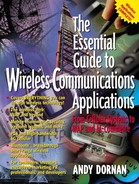Chapter 11. Fixed Wireless Technology
In this chapter…
Compared to mobile technology, fixed wireless can seem rather unexciting. In some respects, this skepticism is justified: it doesn't involve fancy gadgets, revolutionary applications, or anything that tracks a user's location. Fixed wireless is used for exactly the same applications as wireline technology, competing directly with it and offering the same high data rates. Fixed systems can provides 100 Mbps or more, capacity that will never be available while mobile.
Over long distances, there is no doubt that wires have won. A single strand of fiber-optic cable can carry many petabits of data per second, covering hundreds of miles before it needs to be amplified. It's a different story in the local loop; though fiber networks are being constructed beneath major cities, these usually just serve the financial center. Outside of these small areas, analysts estimate that most customers will have to wait until 2020 before it reaches their homes.
Broadband wireless systems are here now and expected to be widely available by 2003. Whether bringing telephone service to remote villages or competing with cable TV in the suburbs, carriers usually find it easier and cheaper to set up transceivers than to tunnel through the ground. They also have uses outside the local loop, in private and mobile networks. Cellular base stations are already positioned for optimum radio coverage, so fixed wireless provides an easy way to link them together.
Many in the networking industry believe that within ten years, fixed wireless will be how most desktop computers (as opposed to mobile devices) are connected to the Internet. And although wireless will never be as fast as fiber, new laser systems are pushing the boundaries even further.
